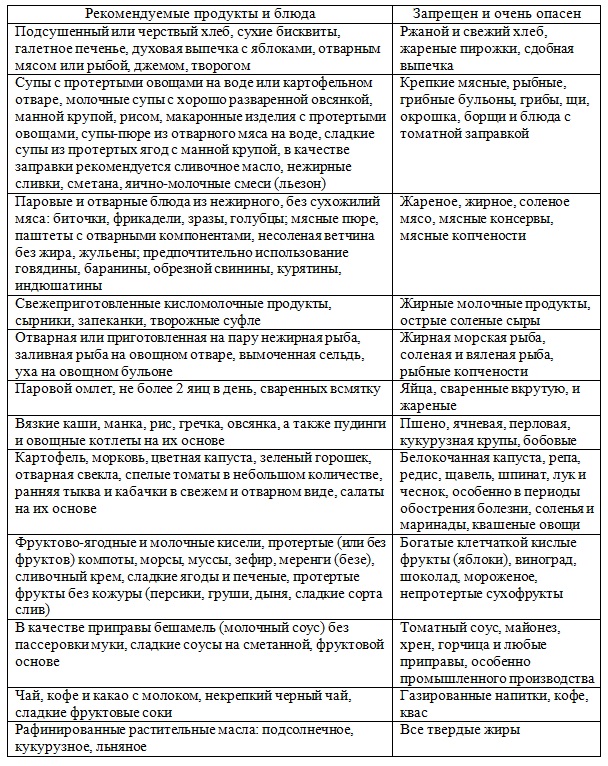Diet recipes for people with coat of arms. Organization of a diet. The basic principles of clinical nutrition with coat of arms.
Correction of eating behavior is the most important factor in the prevention and treatment of gastroesophageal reflux disease (GERD). Long-term remission of the disease cannot be achieved exclusively by medical methods, without proper nutrition.
Disruptions in the functioning of the digestive tract and the resulting distortion of appetite complicate the processes of normal secretory processing and assimilation of food. The uniformity of the diet of people suffering from GERD leads to the need to organize a full and varied diet.
Intense physical activity increases pressure in the abdomen, and any exercise based on frequent and deep bending will only worsen the condition. It is better to go to classes with moderate intensity - go for a walk, ride a bike, swim - and, of course, immediately after eating. Some foods stimulate sensory nerve receptors in the mucous membranes of the esophagus. If such stimulation changes with membrane reflux, the patient feels pain behind the bridge, burns. Among the products that affect patients with reflux are.
Citrus fruits and juices from them are tomatoes, tomato juice and even ketchup, acidic food spices, alcoholic onion vegetables or onions, garlic, onions, leeks, smoked and pickled. In the fight against pain and baking, you must remove these product groups from the daily menu.
Dietary nutrition is an essential part of an integrated treatment process, and sometimes a decisive factor in the healing process.
Proper nutrition organization can change the physiology of the processes occurring in the body, increase the speed and intensity of metabolic reactions, the body's resistance and even enhance the effect of the use of certain drugs.
Well, it's also the perfect recipe for long hours of heartburn. Alcohol, chocolate, coffee and fat reduce the pressure of the lower esophageal sphincter, cocoa, caffeine and ethanol, empty gastric emptying and increase the secretion of hydrochloric acid. It is worth considering choosing your favorite dessert. Products authorized and contraindicated.
Another problem to consider when treating reflux is the most commonly used pharmacological agents that can cause food shortages. When using proton pump inhibitors, people who prefer a non-meat diet to cover the need for these ingredients can be quite difficult. It is also worth considering going to a nutritionist for advice on how to balance your diet. It is very important to use a suitable diet when treating reflux disease. Often also the cause of reflux is the wrong way to eat.
Edible "means of destruction"
The main principles of nutrition in GERD are dietary selectivity and an adequate diet. Given the etiology of the disease from the diet, it is necessary to exclude products that can affect:
- on the tone of the lower esophageal sphincter (NPS) - strong coffee, tea, alcohol, sweet carbonated drinks, legumes;
- the condition of the inflamed mucous membranes of the stomach and esophagus due to its composition or consistency;
- for the production of hydrochloric acid of the stomach - an excess of meat dishes, chocolate, fatty foods;
- on the speed and quality of gastric digestion due to its structure and (or) temperature.
The organoleptic characteristics of food that affect the condition of the mucous membranes and the quality of gastric digestion include:
Right and featured dishes. Dishes and ingredients to avoid Fatty foods, fatty meats and poultry, such as fatty pork, goose meat, duck, pork shank, ribs. Avoid fatty dairy products such as yellow cheeses, Camembert cheeses, cheese, melted cheeses and molds. People with a refluxed stomach should move away from junk food as quickly as possible. Do not eat foods such as hamburgers, hot dogs, cheeses, fries. Especially onions, consuming it in excess, can contribute to the formation of reflux. You cannot, if you have reflux in your stomach, to do strokes with onions. Avoid dishes with vinegar and pickled mushrooms, vegetables and fruits. It is not recommended to add vinaigrette to the dishes during reflux. Avoid spicy foods with pepper, curry, and chili. Do not eat spicy Mexican or Chinese dishes. If a person has reflux Salf, you risk returning food back to the stomach. Fruit juices with oranges and lemons can cause and increase heartburn. starvation. Alcoholic drinks are not allowed and harmful in the case of this disease. People with stomach reflux should ensure that they don’t wear clogged clothes or belts, or just loosen them when eating. A diet for reflux is a good way to get rid of baking the esophagus. It is also very useful in pharmacological treatment. In addition to a proper diet, you can use other methods.
- Thick dairy products such as yogurt, milk, kefir, buttermilk.
- It is not recommended to drink mint tea.
- And you will find more information about reflux.
- For gastric reflux, it is not recommended to eat fried foods.
- Vegetables are not recommended to eat tomatoes with cucumbers and onions.
- acid content;
- consistency;
- temperature;
- fat content;
- gas content.
When building a diet, you should focus on individual feelings. Discomfort (especially heartburn) in the stomach associated with the use of a particular product, even from the list of allowed - a serious reason to abandon it.
Change in eating habits with reflux
Not shown for reflux. Persons with a known reflux disease should change the wrong meal. It is very important to reduce the amount of fat in your diet. It is better to eat cooked food, baked than fried. You must reduce all ingredients of foods that are heavy, such as yellow cheese, fatty meats, meat, processed cheese. They slow down the emptying of the stomach, causing unpleasant discomfort in the upper gastrointestinal tract.
It is worth taking care of the regularity of food intake. Eat small meals and more often at regular intervals, for example, every three hours. It is worth reducing the number of dishes. This exacerbates the symptoms of reflux, because the lower tension of the esophagus of the sphincter decreases, because the stomach is stretched under the influence of the digestive tract. This condition can cause the pulp to return to the esophagus.
Organization of diet
The main principle of organizing a diet in GERD is its multiplicity. Fractional nutrition is designed to provide a uniform load on all organs of the gastrointestinal tract and avoids increasing pressure inside the abdominal cavity.
Eating is carried out 5-6 times during the day and not more often than 1 time in 3 hours. Excess portions of food stretch the inflamed mucous membrane of the stomach, disrupting the blood circulation in it, injuring and leading to dystrophy and thinning.
It is worth eating food alone, without rushing, carefully chewing every bite. Eating too fast makes us swallow air and abdominal walls. This condition further exacerbates the symptoms of reflux disease of the esophagus. Try not to eat too late in the evening and at night. It is best to eat two or three hours before bedtime. The intensity of the symptoms can be felt at night in a supine position, because then the mechanisms that are responsible for self-cleaning of the esophagus do not work properly. If you smoke, it is best to quit this addiction.
Similarly, drinking alcohol. These addictions reduce the lower esophageal sphincter. Smoking causes a decrease in the secretion of saliva, which is responsible for cleansing the esophagus from stagnant nutrient content. It is desirable that the diet is easily absorbed and reduces substances that stimulate the secretion of gastric juice.
Lunch can consist of one dish, it is not necessary to traditionally make it of three dishes. The intervals between solid and liquid foods must be observed.
It is not recommended to eat less than 2 hours before bedtime. Until the process of gastric digestion is completed and the food is in the stomach, the NPS is in a relaxed state. Therefore, immediately after eating, you should not take a horizontal position, this can provoke reflux. In the supine position, especially on the right side, the probability of throwing food is maximum.
Other nutritional recommendations for gastroesophageal reflux
The main recommendation for a stomach reflux diet is to limit foods that increase the secretion of hydrochloric acid.
Why a diet is suitable for reflux disease
- Eat five small meals a day.
- Eat regularly.
Digestive overture
Chewing food is the initial stage of the digestive process. The normal work of the stomach and the assimilation of food directly depend on how well its preparation in the oral cavity has gone. The consistency of the food mass and its impregnation with the secretion of the salivary glands, having an alkaline reaction, and, therefore, capable of partially neutralizing the effect of gastric juice, depend on the manner of eating food. Poorly chewed rough food can be an additional irritating factor for the mucous membranes.
Example menu for reflux
First breakfast bread with cottage cheese, cucumber and radish. Apple juice or beetroot juice. Lunch Rye bread with margarine, poultry ham, cucumber. Afternoon tea with natural yogurt. Dinner Rye bread with margarine, pork sausage, banana.
Following a reflux diet will help alleviate the symptoms of the disease. A reflux diet should exclude certain foods that increase gastric acid secretion and bounce after eating. From the list, you should often and always use with you to make sure that even eating outside the home does not expose yourself to unpleasant symptoms.
Hasty food in combination with lively conversations contribute to swallowing air, burping and / or reflux.
Cooking Features
The technology for preparing dietary dishes is based on thorough thermal and mechanical processing of products: grinding in a meat grinder, rubbing, steaming, baking without crust. For baking, pre-cooked meat is used.
With reflux, you cannot eat
Any boiled vegetables, frozen and canned. Skinny milk and low-calorie dairy products. Fruit and vegetable juices, peeled fruits, especially apples of white flour and baked: bread, pasta, crackers. Lean meat, poultry, sea fish, seafood, tofu, egg cream. Soups and broth Bad green tea Peanut butter Baked, cooked and grilled dishes. As stated above, it is very important to reduce the amount of fat in the diet. For this reason, it is advisable to eat boiled and baked foods rather than fried in deep oil.
Liquid diet is a fundamental principle diet food.
Fatty, sweet, fried foods require additional time and increased secretion to adequately prepare for intestinal digestion, therefore it lingers in the stomach, leading to congestion, excess production of hydrochloric acid.
Appetizing-looking ruddy crusts can be dangerous due to the high content of resins and other carcinogens in them and also stimulate an increase in acidity.
Diets should be excluded from diets that are difficult to digest and increase the risk of biting food into the esophagus. Equally important is how we eat. Do not eat hot dishes, but warm. Do not eat with food. Stop smoking and avoid drinking alcohol and coffee. Drink plenty of fluids. Limit salt and spices. Wipe and dine if possible. Make fruit and vegetable smoothies, mix, squeeze juice. Stop foods that cause bloating and heartburn. Pulses, cabbage, dark bread.
- Eat less, but more often.
- Eat calmly, slowly.
- Chew each piece thoroughly.
- Avoid eating at bedtime and snacking at night.
- Do not skip breakfast.
Diet formation
Red meat (beef, lamb, pork) should be consumed no more than 2 times a week.
Dairy products are an indispensable source of calcium, but milk intake should be moderate. It is better to give preference to low-fat dairy products.
The main source of protein should be fish. The probability of containing harmful and hazardous substances is less in small sea fish.
What is intestinal reflux? This is a functional digestive upset. This manifests itself when the main content of the duodenum does not move to the small intestine and does not recede. It mixes with digestive acids. This, in turn, is toxic to the gastric mucosa.
Causes of gastroesophageal reflux
Gastrointestinal reflux is also sometimes called gastroesophageal reflux. This is most common in people whose gallbladder is removed. However, the cause of this disease can be much more. Not all causes of the disease are well known. Reflux can be caused by a nervous dysfunction that enters the duodenum through the biliary tract. The cause of the disease may be excessive relaxation of the pylorus, a decrease in the strength of motility or a change in the mobility of the pylorus.
 The high protein content in the nutrition increases the body's ability to heal erosive lesions, heal inflammatory foci and speedy restoration of the surface layer of the mucous membranes. It is recommended that meat proteins be introduced into the diet in a crushed form, so as not to stimulate additional acid formation and reduce the energy expenditure of the body for splitting.
The high protein content in the nutrition increases the body's ability to heal erosive lesions, heal inflammatory foci and speedy restoration of the surface layer of the mucous membranes. It is recommended that meat proteins be introduced into the diet in a crushed form, so as not to stimulate additional acid formation and reduce the energy expenditure of the body for splitting.
Symptoms of gastrointestinal reflux
Reflux can also cause vasodilation, blood stasis, or stomach hyperplasia. Bile, which goes where it should go, does not cause prostaglandin secretion. for the protective mechanisms of the gastric mucosa. Symptoms of this disease are, as a rule, severe upper abdominal pain and concomitant biliary vomiting. However, the symptoms of reflux may be greater and may be combined with other unpleasant symptoms. An extremely common problem is the sensation of a reverse stroke when we are lying or lying down.
Oatmeal, buckwheat, brown unpolished rice are sources of fiber, vital for a person, but in the acute phase of the disease, porridge should be thoroughly wiped. The use of sweets, fresh fruits and vegetables immediately after eating can provoke the fermentation processes of the food mass.
Pevzner diets
The choice of any diet implies an individual approach. Almost a hundred years ago, the Soviet nutritionist M.I. Pevzner developed a diet system, which is part of the comprehensive treatment of a number of diseases. An outstanding scientist has developed more than 15 types of diets, covering the maximum possible range of diseases. Each type of diet is called a table and has its own number. The use of such tables has helped to provide the necessary individuality in the approach to nutrition.
In addition, you may experience problems such as trouble swallowing, swallowing pain, sudden weight loss. These symptoms are worse, especially after a big and heavy meal. Moreover, often heartburn can be caused by retardation of the contents of the stomach, which complicates the work, the pain can be extremely unbearable.
How to diagnose gastrointestinal reflux?
Diagnosis of gastrointestinal reflux is possible using radioisotope testing. The patient receives food along with an isotopic tag that stains the contents of the duodenum. This allows you to take a radiological photograph later, where you can see if the duodenum returns to the stomach. Your doctor may also perform a biletec test. It consists of measuring the amount of bile within 24 hours. After local anesthesia is applied, a probe is inserted through the nose into the stomach.
Variations in a number of diets are indicated by letters within each group. Options for diets ensure the continuity of treatment and a gradual sparing transition to good nutrition.
In modern dietetics, tendencies to revise a number of certain provisions of the theory of M.I. Pevzner in connection with new approaches in dietetics, to avoid a clear delineation of tables are intensified, but the clinical picture of GERD allows the use of dietary principles of tables No. 1 and No. 1b.
Table No. 1. In practice, a diet is a complete diet; it is indicated for compensated diseases of the stomach and duodenum.
Table number 1b. Indications for use are: gastric ulcer and duodenal ulcer in the stage of mild exacerbation or remission, exacerbation of chronic gastritis with increased acid separation, and acute gastritis in remission.
Diet veto
Despite a number of restrictions, the list of products allowed under the GERD is impressive:

Constant monitoring of the diet will help relieve acute symptoms for several days and reliably prevent relapse of the disease.
GERD Diet
The purpose of the diet: healing of erosive and ulcerative lesions of the mucous membranes, stimulation of excretory and gastric motility.
Characteristic of diet table No. 1: complete in composition of basic nutrients (daily food intake includes 100 g of protein, 100 g of fat and 400 g of carbohydrates) and calories. The daily energy index is 2800-3000 kcal. For urban residents, daily intake should be limited to 2000. Calorie restriction is especially important when prone to overweight. Losing weight reduces the risk of complications in the form of a hiatal hernia.
Temperature requirements of the diet: the temperature of hot dishes - not more than 60ºC, cold - not less than 15ºC. Salt intake is limited to not more than 8 g per day.
Important! The intake of alkaline mineral water is shown exclusively during the period of remission. The presence of tea in the diet is allowed, but not strong and not hot, preferably before meals or two hours after it.
According to some modern nutritionists, salt should be completely excluded from the diet. It comes in sufficient quantities with food, a lot of salt is found in bread and industrial products, especially tomato juice.
Sample daily diet menu table number 1
At the time of GERD exacerbation, dietary requirements are tightened: instead of crumbly cereals, smeared cereals are recommended, dried fruits should be thoroughly wiped, and dairy products excluded from the diet.
1 breakfast: steam omelet, mashed buckwheat porridge, tea with the addition of milk.
2 breakfast: cottage cheese casserole, pear boil.
Lunch: home-made noodles, cabbage rolls in sour cream, apple compote.
Snack: fresh carrot juice, biscuit.
Dinner: steamed fish with grated boiled beets, weakly brewed tea.
At night, a glass of fresh kefir or yogurt.
Note! Green tea with honey with all its ego benefits produces a noticeable choleretic effect. The release of bile at the time of spasm of the duodenum can provoke the appearance of bile reflux.
Diet recipes
The fundamental approach to the culinary processing of food and its main goal is to maximize the preservation of nutrition, vitamins and essential trace elements. Below are simple recipes that satisfy these conditions.
Rice Dumpling Chicken Soup
It will require chicken, a small carrot, 1-2 onions, rice and an egg. Pieces of chicken should be cooked without skin. During cooking, you can add for a while a small onion in the peel, from this the broth will acquire an appetizing golden color and a unique onion flavor. Cut a small onion and carrot into cubes and add to the broth when the chicken reaches half-ready.
While preparing the broth, you need to boil the rice, and at the very end of cooking you should add a little milk to it. Add the egg and a little butter to the boiled rice, form dumplings, roll in flour if necessary.
From the finished broth, get the chicken and put the dumplings. Cook for 10 minutes. Add some greens to taste. During an exacerbation of the disease, the broth should be diluted in half with water.
Diet Meatballs
The remaining boiled meat should be finely chopped with a knife or minced, mixed with the remaining rice, add the egg and cook in a double boiler.
Baked Cauliflower
Cauliflower should be boiled in slightly salted water and disassembled into small inflorescences. Then lay in a mold, pour over with beaten eggs and bake, avoiding the appearance of a crust (or cook for a couple).
Carrot-curd souffle
The peeled large carrots must be cut into small pieces and boiled in milk, then rub well through a sieve and add 50 g of cottage cheese thoroughly mashed with a fork. To the resulting mass add sugar to taste, a beaten egg, 10 g semolina, a slice of butter, mix and steam.
Vegetable Soup
Boil two tablespoons of washed rice in a small amount of water. After filtering the broth, rub the cereal through a fine sieve. Then mix in equal proportions with mashed potatoes and carrots and place in a decoction. Add milk to taste, bring to a boil. Season the finished soup with yolk and butter.
Due to the uniqueness of each person, various causes and the course of the disease, there is no diet suitable for all exclusion bases. Doctors sometimes recommend keeping a food diary to create their own menus.
To overcome the difficulties of the "transition period" will help some of the installation:
- lead an active lifestyle, transform stress into reasonable physical activity;
- do not expect immediate results;
- be disciplined and consistent in dieting;
- maintain a positive attitude;
- GERD is a personal “acquisition” and only the patient can get rid of it;
- throw out the salt shaker.
Failure to diet will inevitably lead to the starting point of the disease, but already in a complicated form.
Health is an irreplaceable resource, the preservation of which depends largely on the person himself. Strict adherence to the principles of diet can effectively reduce the frequency and duration of reflux episodes.
GERD in most cases proceeds in a chronic form with frequent relapses. At first glance, it seems that the pathology is unpleasant, but not dangerous. But constant irritation of the mucosa can lead to complex diseases that are life threatening. Treatment of the pathology is long, but the diet with GERD with esophagitis is especially important. Only thanks to her can achieve a stable remission and normalize the state of the whole organism.
Without a diet, treatment may be delayed and may not produce the desired effect.
Diet purpose
Just note that the concept of "diet" is used not only in cases where you have to practically starve.
In diseases of the gastrointestinal tract, it is enough to abandon certain foods and adjust the diet so that the body receives all the necessary substances. Hunger is not felt.
Before picking up proper nutrition, it is important to understand why this is already being done. The purpose of the diet will be:
- decreased probability of refluxing into the esophagus;
- mucosal restoration;
- prevention of malignant degeneration.
Prohibited Products
First of all, it is important to find out which foods cause heartburn. Also important is the time of eating, its method of preparation, and even temperature. Food should contain enough simple protein, but it’s important to cut back on sweet foods and starch.

Reducing sugar intake helps normalize digestion in the disease
We will deal with sugar. The fact is that it contributes to irritation of the gastric mucosa. But the most dangerous thing is that when eating sweet foods, the production of gastric juice increases. It is also important to consider that sugars are involved in the formation of gastric gas, which causes bloating and burping. In addition, pathogenic bacteria multiply in such an environment, which can be the cause of inflammatory processes. If you drastically reduce the consumption of sweets, cakes, jam and sugar, you can notice that there was a lightness in the stomach, heartburn disappeared and digestion returned to normal.
Separately, it is important to consider chocolate. Besides the fact that it contains a huge amount of sugar, it also has caffeine. This substance reduces the ability of the sphincter to contract. In other words, with the frequent use of chocolate, the entrance to the stomach is constantly open and the food will be thrown, burning the mucous membrane.
The next dangerous product is fat, or rather fried fatty foods. It, like caffeine, causes sphincter weakness. Of course, you can’t completely refuse fat. But it is important to distribute their consumption evenly throughout the day. In addition, in calories, fats should be no more than 1/3 of the daily volume.
Also, nutrition with this pathology should contain a minimum of spices. First of all, it is red pepper. It irritates the mucous membrane and provokes acid production. The same applies to many other spices, so it is better to reduce the consumption of all types of aromatic additives.

For effective treatment limit spice intake
It is especially important to consider tomatoes. They should be excluded even when the pathology is quiet. This applies not only to fresh vegetables, but also to juices, pastes, sauces and so on. The whole danger of the substances contained in tomatoes is that they disrupt the functioning of the muscles of the stomach.
Choose drinks
It is worth deciding on what you can drink with such a pathology. Naturally, all alcoholic beverages are banned. This is explained as follows: alcohols are absorbed in the stomach, exerting a negative effect on it. Just like sugar, it contributes to additional acid production.
When drinking alcohol, there is a decrease in contractility, which causes heartburn. With an exacerbation of the pathology, it is important to completely exclude such drinks.
Given that chocolate is prohibited in pathology, one can easily guess that coffee and strong tea will also have to be abandoned. These drinks also relax the sphincter. At the same time, it is necessary to reduce the consumption of caffeine-containing drinks slowly.
Especially a lot of controversy is going on over milk. At first glance, it seems that it should soothe the inflamed mucosa and relieve irritation. The whole feature of the drink is that after entering the stomach it actually reduces acidity, but does it for a minimum period of time. After its acidity increases again, and much more than before milk is taken. Thus, the drink only stimulates the production of acid, and the effect of its use is imaginary.

To prevent stomach cramps, you need to exclude orange juice from the diet
Making proper nutrition you need to minimize the consumption of orange juice. It contributes to spasm of the muscles of the stomach, which negatively affects its work. During exacerbation, juice should be completely excluded from the diet.
Essential oils can also be included in the group of drinks. They are found in chewing gums, artificial drinks and other "goodies." Oils relax the sphincter and irritate the stomach. Therefore, he will have to abstain.
Having decided on what foods and drinks you need to exclude, you can proceed to planning meals. The ideal solution is to divide the daily portion into several parts. The volume for a single meal should be reduced, but snacks should be organized between lunch and dinner. In total, it is important to take food at least 6-7 times during the day, but in smaller portions. The easiest way is to divide the main meals by half.
Nutrition must contain a large number of complex carbohydrates. They are found in rice, pasta and bread. Thanks to them, you will be able to normalize the acidity of the gastric juice and prevent heartburn. Proteins will also be important. They are found in foods such as beans, lentils and so on.

By adding rice to your diet, you can prevent heartburn.
Chew food thoroughly. It is strictly forbidden to snack on the run. Allow at least 20-30 minutes for a meal. In this case, do not rush or be distracted.
Immediately after lunch or dinner, do not lie down on the sofa. Try to take a walk or sit on a chair for at least an hour to top part torso remained upright.
If during an exacerbation it is not possible to get rid of heartburn, you can contact a therapist or nutritionist. Specialists will help you choose the right menueffective in your case. At the same time, they will take into account the acidity of the juice, the presence of concomitant pathologies, even your eating habits.
Approximate diet
In order not to experience hunger during treatment, it is enough to competently approach the preparation of the menu. Even during an exacerbation, when you can afford the most favorite dishes.
There are a huge number of products that are allowed to be consumed during this illness. It is important to consider the method of their preparation. This can be boiling, stewing, steaming and so on. The only thing you need to reduce the use of fried foods. For example, consider the following menu:

Knowing the list of allowed and prohibited products, you can significantly diversify the proposed menu. You only need to stock up with desire and patience and perceive the diet as the right way of life, and not as an unpleasant treatment.
In the video provided you will find additional information about the diet for GERD:






